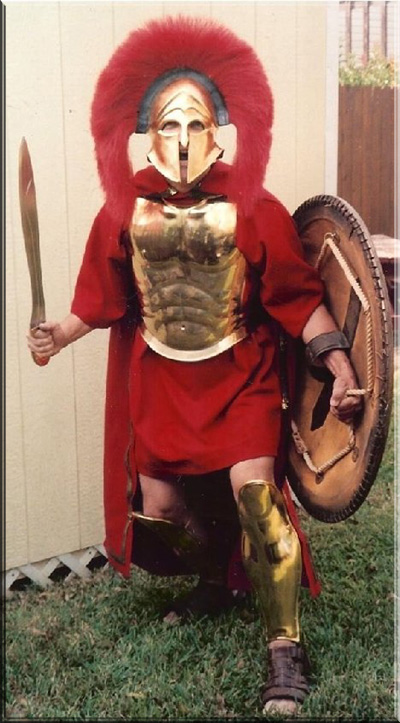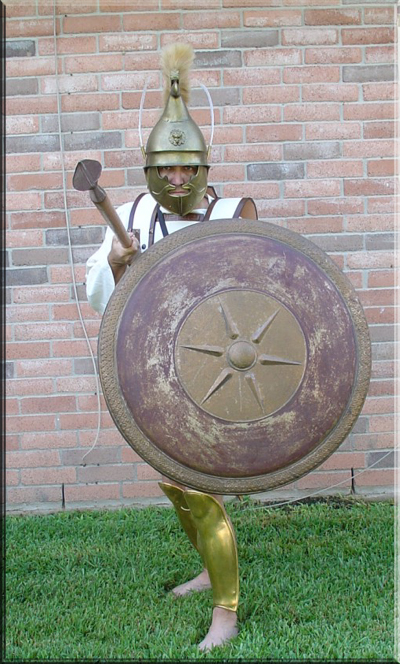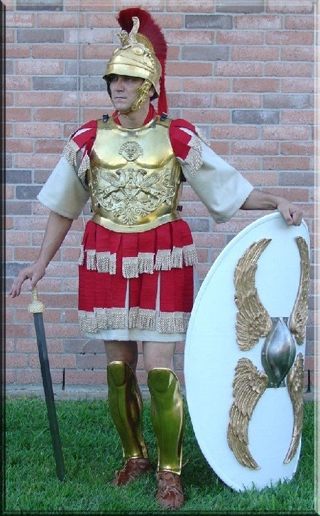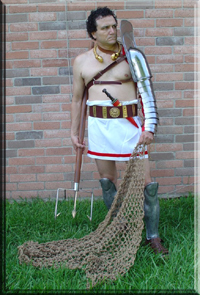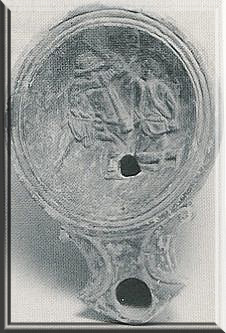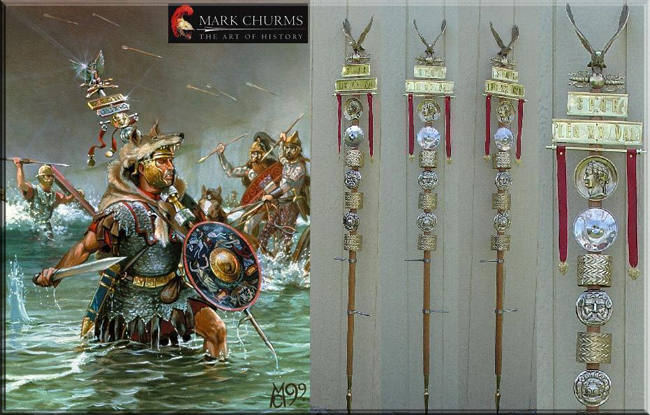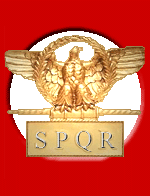

![]()
by Terry Nix
"300" - GETTING IT RIGHT
The movie "300" gave viewers an exciting story portraying the legenedary battle of Thermopolae. The costuming however was copied from a comic book version of the story and got it wrong. Below, a member of Legion Ten has made a persona based from an actual Spartan soldier bronze statue.
MACEDONIAN IMPRESSION
In this impression I am wearing linen cuirasses of three different designs. Each cuirass starts off as 1/4" thick leather and then has two layers of glued-linen on top of it. The tunics are a mixture of red and white long sleeve linen tunics and red, white and brown wool tunics. The Medusa head in the third example is done in the ancient Greek grotesque Gorgone style.


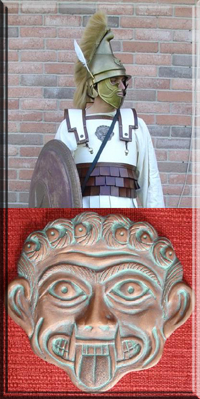
The Phrygian helmet has a crest running down it's length and feathered side plumes. This design is copied from a rare coin minted in ancient Bactria depicting the helmet and armor of Alexander the Great during his Indian campaign. On the front of this coin, King Porus is seen on an elephant being chased by Alexander on Bucephalus.
The small lion's head device on the brow was influenced by the helmet found in the tomb of King Philip
The Macedonian star on the shield was the ancient symbol of the Macedonian royal line. The shield rim is designed from the cable-patterened rim of a Greek shield from Bari.
These greaves are gold plated half round muscled design, influenced by the gold-gilded greaves also found in King Philips tomb.
The lower arm guards or bracers are like those seen on a Spartan statue as pictured in Greece and Rome at War (p. 59) and the falcata sword has the head of a horned bull.
Some Greek warriors were armored from head to toe--no less then a Medieval Knight would have been!
REPUBLICAN ARMOR OF JULIUS CAESAR
This armor was influenced by two original three dimensional sets of Roman armor carved in marble.The first was part of a panoply of arms or trophy of arms I took pictures of at the Museum of Italian Civilization built by Mussolini just south of Rome.
The helmet is decorated with a griffin in the front of the crest. This was done before in a smaller size but I went ahead and took it up a few notches with this new larger more detailed design which really grabs your attention when compared to the first one. It is closer to the original in size and a lot more majestic looking. The armor decorations come from the early Imperial period.
The tunic is white wool and--while most Roman thought today is that pteruges were either linen or leather--I used neither one here as there is no proof that leather or linen was always used.
I used red woolen felt about 1/8 thick as it was a common material of the time and known to have been used by the Romans.
If you glue a couple of these together, it is just as strong as any linen pteruges and one can actually shape or form woolen felt into shapes unlike linen.
The Roman military use of felt for other than helmet padding should not be overlooked. Several Roman soldier hats have been found made of felt and Julius Caesar himself mentions that his soldiers made felt tunics for protection along with other materials during the battle of Dyrrhachium in 48 BC with Gnaeus Pompeius Magnus. So, felt is a legitimate material to use for pteruges if one desires.
It's military use reaches from the ancient up to the modern times. Napoleonic officers hats were woolen felt which can be made pretty hard as I have owned a couple in my collection.
The problem is, they used mercury in the process. That was about as good an idea as using lead in Roman makeup.
Original all brass Roman Consuls helmet.
A few years later I decided the Griffin was not an essential part of the helmet and removed it and did away with the tail as well.
Instead of cast brass, it is now plated in gold. The first ones you had to handle with latex gloves to keep them from tarnishing. Gold never tarnishes.
A few months ago I took 180% turn and then decided to make it even nicer with a larger more detailed and more accurate Griffin and fuller crest with a fuller tail.
The sword I gave this officer is an eagle headed spatha which makes more since to me as an officer would have been on horse back and he needed the extra reach to protect himself as well as his horse. The shield is of the Praetorian or Republican style and is not the new Deepeeka one. The shield boss has a strengthening rib down it's center.
The greaves here are gold plated. Many ancient military items have been found that are silver and gold plated or gold gilded according Dr. Ernst Künzl, curator of the Römisch-Germanisches Zentralmuseum. Not all were officers or Kings either as several items have been found that would have belonged to every day soldiers. Julius Caesar implored his men to put their money into their equipment. That may be why you find silver work on so much Roman military stuff. I have seen some cingulums where the belt parts are actually solid silver as well as gladius and pugio parts. I own a Roman pugio with inlaid silver on the handle that is so fine and so perfect, it is work of art unto itself. Each line of silver is unbelievably straight with the width of a writing pen line. I will do a study on it someday.
The shield I have done was actually made a couple of years ago and is more Praetorian looking then the new Deepeeka Republican ones. The shield boss has a reinforcing rib down the middle of it with in effect doubles it's strength. The wings on the shield are done in high relief instead of being painted on. Dan Peterson as well as myself believe this was done. How they did it or what materials were used are not known.
We know that chainmail was painted onto many grave stelae which was done many times by just drilling holes when sculpted. Why would they paint on chainmail but then go to the trouble of carving out in high relief marble all the detailed feathered work and lighting bolts on the same grave stelae? Brass has been suggested for these but I also think these parts could have been cast in molds. Wood pulp, plus glue and other fibrous materials could have been cast in a molds, making it a mass production item.
Oh well, the only evidence to support this is thousands of sculptures in Rome and on the frontiers but in this same sentence I can also say not one rectangular scutum or shield have even been found for the entire first century AD and entire second century AD and we all base those we use now entirely on sculpture.
Even 95% of the brass shield rims that have been found are for oval shields. The only true rectangular shield was found at Dura Europus and that was third century and in a time they were out of use. The thickness of that shield also leads to the fact, that it was most likely used for parade only and not for battle.
Ah, isn't this just great. The more we know, the less we know for sure. . . .
RETIARIUS GLADIATOR
The retiarius was a late comer to the gladiatorial games and is not seen in Roman Republican or early Empire depictions. He did not fit in with the more armored or more military equipped looking gladiators. He carried no shield and wore no helmet. The galerius or shoulder guard was his main defense along with the sometimes-used manica. Most of these shoulder guards went straight up and not bent outwards as most grave stelae and Roman figurines show. The manicae also seems to be normally of metal or possibly leather and not cloth when used based on these same examples.
Although they were easily identified by their nets, these retiarius seemed to have a macho problem with that, so they are depicted many times only with trident and dagger or fighting with mainly the trident and dagger. Experts will tell you that the only gladiator that fought the retiarius was the secutor with the rounded helmet.
In my personal collection of four gladiator oil lamps, one shows a retiarius fighting a murmillo which is one of only two examples known to show this line up of gladiators. The other is in a museum in Germany. No net can be seem but the retiarius trident is about go into the belly of the murmillo. The retiarus is also fighting with a dagger. His dagger is about to go up into the neck of the murmillo with his left hand as the right arm holds the trident at his belly.
The coloring muddles the relief, so I added a black and white which helps to show better distinction. This lamp also shows the retiarius wearing a tunic which is a little different.
"Never say never" is my motto. . .
MARK CHURMS' STANDARDS
Artist Mark Churms depicts Caesar's landing on the beaches of Britain in this painting from his series "The Art of History." In fact, this is the very moment when Legion Ten's Aquilifer takes the lead to storm the beaches, thereby motivating the other troops to follow him. Losing the Legion's eagle to the Britons would have been a tremendous humiliation and the risk of it was enough to prompt the men to disembark from their ships for battle and to protect their eagle. Mark Churms' wonderful art strongly influenced my construction of the accompanying standard.
For comments or remarks concerning any of the above, you can email me at legate@legionten.org


